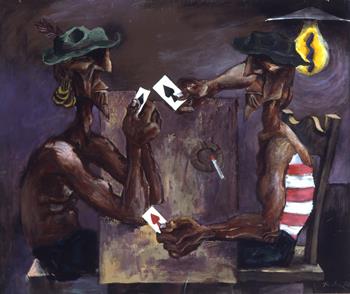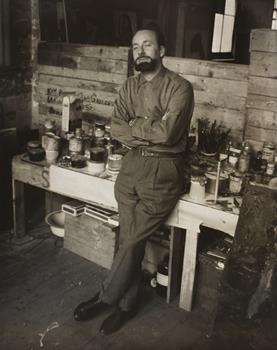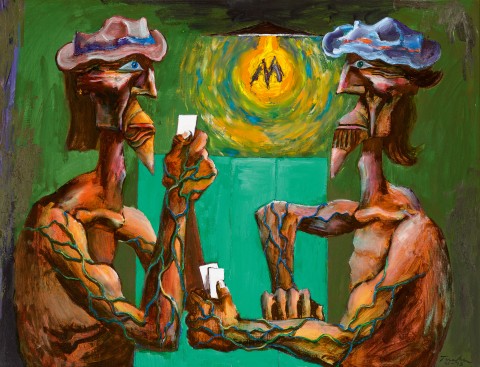THE CARD PLAYERS, 1961 - 73
ALBERT TUCKER
oil on composition board
75.0 x 100.0 cm
signed and dated lower right: Tucker / 61 – 73
inscribed verso: IBIS IN FLIGHT
Tolarno Galleries, Melbourne
The National Australia Bank Art Collection, acquired from the above in 1978 (label attached verso)
The Seventies: Australian Paintings and Tapestries from the Collection of National Australia Bank, National Gallery of Victoria, Melbourne, 15 October – 28 November 1982 (label attached verso)
The Seventies: Australian Paintings and Tapestries from the Collection of National Australia Bank, Geelong Art Gallery, Victoria, 30 April - 29 May 1988
'The Seventies' Exhibition: Selected Paintings from the National Australia Bank Collection 'Modern Art of the Seventies', Caulfield Arts Complex, Melbourne, 18 January - 11 February 1990, cat. 23
Lindsay, R., The Seventies: Australian Paintings and Tapestries from the Collection of National Australia Bank, The National Bank of Australasia, Melbourne, 1982, pl. 92, p. 105 (illus.)
'The National Australia Bank collection of modern art in the seventies', National Bank, CBC Bank: Group News, October 1982, p. 6 (illus.)
Card Players, 1972, oil on composition board, 77.5 x 92.0 cm, in the collection of Heide Museum of Modern Art, Melbourne
210727 TUCKER CARD PLAYERS.jpg

Albert Tucker left Australia bound for London in late 1947, recalling that, ‘for me it was like undoing a coiled spring. You could go and see and experience things you had only known by report.’1 He spent the next thirteen years living and working in Europe and America, being exposed to the art, history and rich culture of Paris, Rome, New York and other great cities. Absorbing all they had to offer, he experimented with technique and a diverse range of themes, synthesising and distilling these influences to develop his own distinctive style. For Tucker art was a vocation, and he held strongly to the belief ‘that to create easy and saleable art was merely an acquired skill, [but] to create challenging and culturally important art was the true purpose of the artist.’2 It was this uncompromising vision and Tucker’s determination to make art of substance that sustained and motivated him and which, toward the end of the 1950s, saw him achieve the acknowledgement he had long sought.
A significant turning point occurred in 1958 when Alfred Barr, Director of the Museum of Modern Art, New York, saw examples of Tucker’s recent paintings in the stockroom of Poindexter Gallery on his regular weekend rounds of the city’s commercial galleries. Impressed by the strength and originality of what he saw, Barr recommended a purchase to the museum’s Board and the subsequent acquisition of Lunar Landscape 1957 placed Tucker’s work in the company of the best twentieth century artists in what was arguably the most significant collection of modern art in the world. Although his practice was yet to be acknowledged in this way by any major gallery in Australia, this critical recognition of his art gave Tucker the confidence to persist and pursue his current direction. Success continued and in the same year Tucker won the Australian Women’s Weekly art competition, famously receiving the news that he had been awarded the one-thousand-pound prize at a time when he had only a few dollars left in his pocket.3 A commercial exhibition in New York in 1960 resulted in the purchase of a second painting by MOMA, and another acquired for the collection of the Solomon R. Guggenheim Museum.
Tucker returned to Australia in 1960 to participate in a major survey exhibition of his art of the past five years that was being organised by John Reed and the Museum of Modern Art of Australia. The exhibition was well-funded and unusually for the time toured to every state (where it was shown in commercial galleries), as well as to regional galleries in Newcastle, Launceston and Mildura. John Reed wrote in the exhibition catalogue that ‘many artists, including Albert Tucker, have felt obliged to leave Australia because of lack of recognition, so it is with special pleasure that we welcome him back as our distinguished guest. Albert Tucker’s international reputation precedes him on this visit; but we can now for the first time see the paintings on which this reputation has been established.’4 Tucker had returned to Australia after his recent success in New York with his head held high and this exhibition brought due acknowledgment of his work in his own country, with paintings being purchased by private collectors and public galleries including the Art Gallery of New South Wales, as well as a feature article being published in Sydney’s Daily Telegraph.
210727.jpg

For some years Tucker’s imagery had increasingly focussed on Australian themes, subjects drawn from the country’s unique history – convicts, bushrangers, explorers – and others based on its distinctive landscape. The theme of the figure in the landscape had first become evident in the Ned Kelly series of the mid-1950s, and by the time Tucker began painting his iconic antipodean heads towards the end of the decade, the figure had transformed and become the landscape. ‘I’d been away long enough to be suffering acute bouts of nostalgia and I was getting all these memory images of Australia – and oddly enough not so much specific imagery, but in images of texture and colour and light and all that kind of thing that’s very Australian, very rough textures.’5 His longstanding friendship with fellow artist Sidney Nolan, whose work had consistently addressed such themes with considerable critical and commercial success, must have influenced this development but so too did something more fundamental. Over time Tucker recognised that although he was living in sophisticated cultures with firsthand access to masterpieces of the Western art tradition, he was always at one remove from his surroundings. Despite the philistinism and stunted appreciation of true art and creativity that Tucker perceived in Australia, he was at home in this country, part of a community (no matter how much of an outsider he may have felt) and possessed an innate understanding of his environment. It took at least a decade of being away from the country of his birth for Tucker to come to terms with this and see Australia in a positive light and as a place that could both inspire and sustain a serious career.
Painted over an extended period of five years, The Card Players, 1968 – 73, is indicative of Tucker’s method of getting the essence of an image down on to the canvas and coming back to it months, or even years later, at a time when he could ‘see the solution and get the final equilibrium.’6 Talking about his studio practice, Tucker described the process of ‘thrash[ing] around wildly and usually get[ting] three quarters of the painting done’ that often characterised the first phase of a new painting. This energy and creative struggle were later replaced by a sense of calm which oversaw the completion of the work: ‘I never have any trouble in being instantly back in time. It is as though I can slide back and pick up where I left off… It is a feeling of plugging in, back in time, with the sense that I am in fact there with all the appropriate sensations.’7
With their sharp, angular features, the stern faces of Tucker’s card players draw directly on the antipodean heads which first emerged in the late 1950s. While these heads were based on the shape of an Etruscan double headed axe, here – more naturalistic and adorned with crumpled, well-worn hats – they are transported to a setting that is instantly recognisable as the Australian outback. The bare lightbulb, its zigzag filament surrounded by an orange glow, highlights the rugged sparseness of the scene, as well as recalling familiar imagery from earlier in Tucker’s career, the distinctive yellow lights that illuminated nocturnal wartime streets in the Image of Modern Evil series. The unsettling atmosphere of those 1940s images is also keenly felt here. The fusion of man and his environment and the inevitable tensions within this relationship was a central theme of Tucker’s oeuvre, and it is highlighted here by the skin of the figures – the colour and texture of dry earth – and the green veins which cover their arms, ‘representing the vital life force… like watercourses in the dry desert.’8 Playing a game of cards, Tucker’s figures suggest a metaphorical competition with fate, a reference to early explorers and symbolic, perhaps, of man’s constant struggle with the environment.
1. Mollison, J., and Bonham, N., Albert Tucker, Macmillan, South Melbourne, 1982, p. 42
2. Gavin Fry, Albert Tucker, The Beagle Press, Sydney, 2005, p. 212
3. See Fry, ibid., p. 159
4. Ibid., p. 18
5. Harding, L., Hinterlands: Albert Tucker’s Landscape, Heide Museum of Modern Art, Bulleen, 2008, p. 31
6. Mollison and Bonham, op. cit., p. 63
7. Ibid.
8. The Seventies: Australian Paintings and Tapestries from the Collection of National Australia Bank, National Australia Bank, Melbourne, 1982, collection notes by Robert Lindsay, p. 108
KIRSTY GRANT
